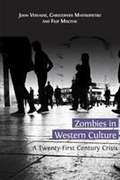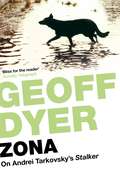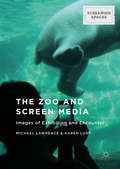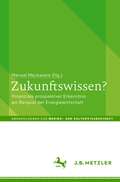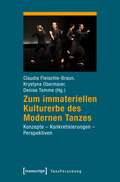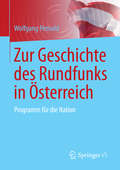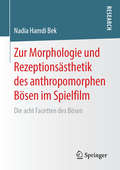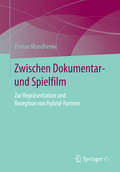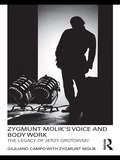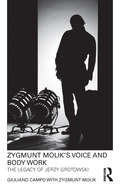- Table View
- List View
Zombies in Western Culture: A Twenty-First Century Crisis
by John Vervaeke Filip Miscevic Christopher MastropietroWhy has the zombie become such a pervasive figure in twenty-first-century popular culture? John Vervaeke, Christopher Mastropietro and Filip Miscevic seek to answer this question by arguing that particular aspects of the zombie, common to a variety of media forms, reflect a crisis in modern Western culture. The authors examine the essential features of the zombie, including mindlessness, ugliness and homelessness, and argue that these reflect the outlook of the contemporary West and its attendant zeitgeists of anxiety, alienation, disconnection and disenfranchisement. They trace the relationship between zombies and the theme of secular apocalypse, demonstrating that the zombie draws its power from being a perversion of the Christian mythos of death and resurrection. Symbolic of a lost Christian worldview, the zombie represents a world that can no longer explain itself, nor provide us with instructions for how to live within it. The concept of 'domicide' or the destruction of home is developed to describe the modern crisis of meaning that the zombie both represents and reflects. This is illustrated using case studies including the relocation of the Anishinaabe of the Grassy Narrows First Nation, and the upheaval of population displacement in the Hellenistic period. Finally, the authors invoke and reformulate symbols of the four horseman of the apocalypse as rhetorical analogues to frame those aspects of contemporary collapse that elucidate the horror of the zombie. Zombies in Western Culture: A Twenty-First Century Crisis is required reading for anyone interested in the phenomenon of zombies in contemporary culture. It will also be of interest to an interdisciplinary audience including students and scholars of culture studies, semiotics, philosophy, religious studies, eschatology, anthropology, Jungian studies, and sociology.
Zombies in Western Culture: A Twenty-First Century Crisis (PDF)
by John Vervaeke Christopher Mastropietro Filip MiscevicWhy has the zombie become such a pervasive figure in twenty-first-century popular culture? John Vervaeke, Christopher Mastropietro and Filip Miscevic seek to answer this question by arguing that particular aspects of the zombie, common to a variety of media forms, reflect a crisis in modern Western culture. The authors examine the essential features of the zombie, including mindlessness, ugliness and homelessness, and argue that these reflect the outlook of the contemporary West and its attendant zeitgeists of anxiety, alienation, disconnection and disenfranchisement. They trace the relationship between zombies and the theme of secular apocalypse, demonstrating that the zombie draws its power from being a perversion of the Christian mythos of death and resurrection. Symbolic of a lost Christian worldview, the zombie represents a world that can no longer explain itself, nor provide us with instructions for how to live within it. The concept of 'domicide' or the destruction of home is developed to describe the modern crisis of meaning that the zombie both represents and reflects. This is illustrated using case studies including the relocation of the Anishinaabe of the Grassy Narrows First Nation, and the upheaval of population displacement in the Hellenistic period. Finally, the authors invoke and reformulate symbols of the four horseman of the apocalypse as rhetorical analogues to frame those aspects of contemporary collapse that elucidate the horror of the zombie. Zombies in Western Culture: A Twenty-First Century Crisis is required reading for anyone interested in the phenomenon of zombies in contemporary culture. It will also be of interest to an interdisciplinary audience including students and scholars of culture studies, semiotics, philosophy, religious studies, eschatology, anthropology, Jungian studies, and sociology.
Zona: A Book about a Film about a Journey to a Room
by Geoff DyerIn this spellbinding book, the man described by the Daily Telegraph as 'possibly the best living writer in Britain' takes on his biggest challenge yet: unlocking the film that has obsessed him all his adult life. Like the film Stalker itself, it confronts the most mysterious and enduring questions of life and how to live.
The Zoo and Screen Media: Images of Exhibition and Encounter (Screening Spaces)
by Michael Lawrence Karen LuryThis book is the first critical anthology to examine the controversial history of the zoo by focusing on its close relationship with screen media histories and technologies. Individual chapters address the representation of zoological spaces in classical and contemporary Hollywood cinema, documentary and animation, amateur and avant-garde film, popular television and online media. The Zoo and Screen Media: Images of Exhibition and Encounter provides a new map of twentieth-century human-animal relations by exploring how the zoo, that modern apparatus for presenting living animals to human audiences, has itself been represented across a diverse range of moving image media.
Zukunftswissen?: Potenziale prospektiver Erkenntnis am Beispiel der Energiewirtschaft (Abhandlungen zur Medien- und Kulturwissenschaft)
by Manuel MackasareVorstellungen von der Zukunft bestimmen das menschliche Handeln. In energiewirtschaftlichen Fragen sind solche Antizipationen besonders relevant: Staaten beschließen Förderprogramme, Unternehmen errichten Kraftwerke, Privatpersonen füllen ihre Öltanks oder ersetzen sie durch Wärmepumpen – stets mit Blick auf ein Morgen, der mitunter trügerisch ist. Kontrovers diskutiert wird, ob es ein Wissen von der Zukunft überhaupt geben und inwieweit es Gegenstand der Wissenschaft sein kann. Die Beiträge dieses Bandes untersuchen Möglichkeit, Methoden und Geltung von Zukunftsentwürfen aus philosophischer, historischer, sozial-, literatur- und medienwissenschaftlicher Perspektive.
Zum immateriellen Kulturerbe des Modernen Tanzes: Konzepte - Konkretisierungen - Perspektiven (TanzForschung)
by Claudia Fleischle-Braun Krystyna Obermaier Denise TemmeDer Moderne Tanz mit seinen pädagogisch-künstlerischen Konzepten (Chladek-System, Elementarer Tanz, Laban/Bartenieff-Bewegungsstudien und Jooss-Leeder-Methode) wurde 2014 von der Deutschen UNESCO-Kommission in die bundessweite Liste des Immateriellen Kulturerbes aufgenommen. Welche Bedeutung haben diese vier Ausprägungen des Modernen Tanzes im zeitgenössischen Tanzgeschehen und in der akademischen Tanz- und Tanzpädagogen-Ausbildung? Die Beiträger_innen des Bandes, darunter Vertreter_innen der vier Systeme als auch der Erziehungswissenschaft, Philosophie, Sportwissenschaft und Tanztherapie, untersuchen die künstlerisch-pädagogischen Konzepte in ihrer Vermittlungspraxis und gehen ihren Entwicklungen und Übersetzungen, Eigentümlichkeiten und Gemeinsamkeiten nach.
Zur Geschichte des Rundfunks in Österreich: Programm für die Nation
by Wolfgang PensoldDas Buch bietet erstmals eine Gesamtschau auf die Geschichte des Österreichischen Rundfunks von den 1920er Jahren bis zur Gegenwart. Es schildert die Entstehung und Entwicklung des Radios ab 1924 und dessen Erweiterung um das Fernsehen ab 1955, und es spannt den Bogen bis zur jüngsten Erweiterung von Radio und Fernsehen um das Internet. Dabei integriert es unterschiedliche Gegenstandsfacetten – technische, politische, ökonomische, soziale und kulturelle – zu einer konsistenten Erzählung. Den roten Faden bildet dabei die Genese der öffentlichen Aufgabenstellung des Rundfunks.
Zur Morphologie und Rezeptionsästhetik des anthropomorphen Bösen im Spielfilm: Die acht Facetten des Bösen
by Nadia Hamdi BekNadia Hamdi Bek befasst sich mit dem scheinbaren Paradox, dass amoralische Charaktere im Spielfilm auch positiv wirken und Faszination auslösen können. Im Fokus stehen dabei die Rekonstruktion der psychologischen Mechanismen bei ihrer Wahrnehmung und Beurteilung durch den Rezipienten sowie die Binnendifferenzierung ihrer Amoral. Im Gegensatz zu herkömmlichen Herangehensweisen zur Erforschung der Rezeptionsästhetik amoralischer Filmfiguren verbindet die Autorin geisteswissenschaftlich orientierte Theorien des Films und der Ästhetik mit der für die Psychologie typischen, dezidiert quantitativen, empirischen Forschungsmethodik.
Zwischen Dokumentar- und Spielfilm: Zur Repräsentation und Rezeption von Hybrid-Formen
by Florian MundhenkeDer Band leistet eine umfassende Text- und Kontextanalyse der Herstellung, Gestaltung und Rezeption von Hybridformen von Gattungen mit dem Fokus auf Dokumentarfilm und Spielfilm. In drei Schritten erfolgt eine Annäherung an Mischformen von filmischen und fernsehspezifischen audiovisuellen Texten. Zunächst wird dabei die historische Entwicklungslinie von Formen anhand von Beispielen und mithilfe theoretischer Ausführungen expliziert. Im Anschluss werden sowohl eine inhaltliche und pragmatische Systematisierung der Formen sowie eine Einbettung in die Bereiche von Produktion, Text- und Diskursgestaltung sowie Rezeption geleistet. Zuletzt rundet eine empirische Studie zum Zuschauerverhalten und zur kontextuellen Einbettung dreier Beispiele die Ausführungen ab.
Zygmunt Molik's Voice and Body Work: The Legacy of Jerzy Grotowski
by Giuliano Campo Zygmunt MolikOne of the original members of Jerzy Grotowski’s acting company, Zygmunt Molik’s Voice and Body Work explores the unique development of voice and body exercises throughout his career in actor training. This book, constructed from conversations between Molik and author Giuliano Campo, provides a fascinating insight into the methodology of this practitioner and teacher, and focuses on his ‘Body Alphabet’ system for actors, allowing them to combine both voice and body in their preparatory process. The book is accompanied by a DVD containing the films Dyrygent (2006), which illustrates Molik’s working methods, Acting Therapy (1976), exploring his role in the Theatre of Participation, and Zygmunt Molik's Body Alphabet (2009). It also includes an extensive photo gallery documenting Zygmunt Molik’s life and work.
Zygmunt Molik's Voice and Body Work: The Legacy of Jerzy Grotowski
by Giuliano Campo Zygmunt MolikOne of the original members of Jerzy Grotowski’s acting company, Zygmunt Molik’s Voice and Body Work explores the unique development of voice and body exercises throughout his career in actor training. This book, constructed from conversations between Molik and author Giuliano Campo, provides a fascinating insight into the methodology of this practitioner and teacher, and focuses on his ‘Body Alphabet’ system for actors, allowing them to combine both voice and body in their preparatory process. The book is accompanied by a DVD containing the films Dyrygent (2006), which illustrates Molik’s working methods, Acting Therapy (1976), exploring his role in the Theatre of Participation, and Zygmunt Molik's Body Alphabet (2009). It also includes an extensive photo gallery documenting Zygmunt Molik’s life and work.

